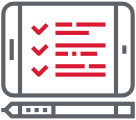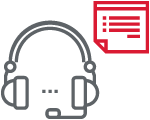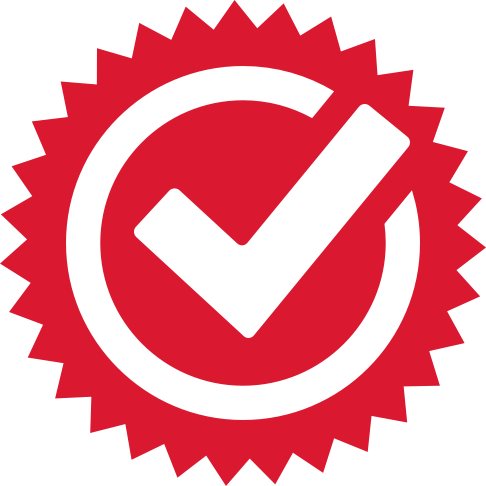Quality Management
Call centre quality management and why it's important
As organisations increasingly compete on the basis of customer experience (CX), call centre performance has become a critical business focus. Workforce management (WFM) solutions can help you properly allocate resources to ensure you’re prepared to meet demand—putting the right people in the right place at the right time to ensure consistent service levels. But agent scheduling and other WFM functionality only covers a portion of the contact centre performance equation. Moreover, agents are not identical—and even the same agent can perform at different levels from hour to hour, day to day or week to week. That’s where call centre quality management (QM) comes in: A QM solution gives you the tools to continuously measure and monitor agent performance, assess the quality and depth of your customer interactions, and drive constant improvement.
The impacts are hard to argue with: A single call between a contact centre agent and a customer can make a lasting impact on that customer’s impression of your organisation. In fact, the success of a contact centre is often directly tied to the performance of the professionals staffing it. Why? There is a strong relationship between the quality of agent and customer interactions and a company’s overall growth. Positive one-to-one engagement between your agents and your customers is the root of brand loyalty, and brand loyalty drives revenue growth. In essence, an effective contact centre quality management programme is directly connected to the success of your business.
Benefits of Quality Management in the Call Centre

Improve Customer Service
When agents receive frequent, constructive feedback, they become better equipped to help each interaction reach a positive resolution.

Increase Customer Retention
Automated QM monitoring can evaluate 100% of interactions, giving call centres full visibility to agent performance.

Understand Agent Interactions
The evaluation process can gather useful data to inform where additional training may be needed to help agents succeed.

Improve Employee Experience
A positive call centre experience drives brand loyalty and keeps customers coming back.

Identify Opportunities for Agent Training
Comprehensive QM programmes help keep agents engaged through regular training and coaching sessions.

Identify Key Agent Characteristics
QM can inform better hiring decisions and training protocols based on past successes.
Approaches to quality monitoring in the call centre
Call centres have many different tools at their disposal to monitor quality. However, each one comes with unique advantages and drawbacks that can make some approaches more insightful than others. Here are a few of the most common approaches used to monitor quality in the call centre, including some helpful tips to identify the right quality monitoring solution for your call centre environment.

Random Sample Monitoring
Many contact centre leaders rely on random sample monitoring to measure agent performance and ensure quality customer service. But this approach is limited in its ability to tell you about the overall state of your contact centre.
In traditional quality assurance programmes, interactions are selected for review based on certain qualities—such as the longest or shortest call—or based on a random sample. Sometimes, a quality evaluator will catch something in one of these samples, such as an agent going off script. But more often than not, these samples will be clean and won’t offer any insights to improve contact centre operations.
Targeted Monitoring
In addition to random sampling, targeted monitoring offers a closer look at high value calls—such as those with key customers or associated with a high dollar value. A call centre might also choose to target calls where a customer is following up on a customer issue or those that are related to key business initiatives including cancellations, low survey scores, renewals, and more.
Monitoring these types of interactions will provide more relevant information and help your call centre improve its processes, finding the specific areas where agents are succeeding or where they might need additional coaching and training.


Analytics-Driven Quality Monitoring
Analytics-fueled quality monitoring and management is the ultimate goal. This fully automated approach enables the call centre to supplement your quality programme with powerful analytics tools like speech, desktop and text analytics. Additionally, you can automatically categorise interactions, regardless of channel, and run predictive scoring on 100% of customer conversations—instead of the traditional 2%.
Analytics-fueled quality management provides insight into the calls, chats or emails that have the greatest impact, enabling supervisors and managers to spend more time on targeted coaching to improve performance. Over time, it helps drive a comprehensive quality programme that targets business issues and processes, turning interactions into valuable data and giving you visibility into key trends.
5 Trends in Call Centre Quality Management
Call centre technology is evolving rapidly. With each advancement, emerging strategies promise to push QM to the next level—delivering new value to the call centre and across the entire enterprise. Here are five trends that are changing the way QM is delivered and revealing new ways organisations can capitalise to create better outcomes—both for their customers and for the business.

Automating Quality (Automation)
Automation makes the contact centre and quality programme more efficient by using technology to collect, analyse and provide insight into customer interactions. It follows an “if this, then that” (IFTTT) approach to processes to help evaluators identify, focus and take action on the interactions that matter most. For example, automation takes the guesswork out of call evaluation by evaluating 100% of interactions and flagging those that need further review.

MULTICHANNEL QUALITY MANAGEMENT
Customers want to communicate with brands in their preferred channels—and sometimes across multiple channels over the course of one problem resolution. While calls remain the most common way that customers contact companies, more customers are turning to other channels for these interactions. This means that brands must be ready and available with a multichannel strategy.
Multichannel Quality Management is the process of capturing and evaluating customer interactions regardless of channel—call, chat, email, social media, etc. This ensures complete visibility into the quality of a contact centre’s performance. A common practise is to have different evaluation forms for each channel, including the standards and requirements that are applicable for each specific channel.

Analytics-Fueled Quality Management
There is simply too much valuable customer information to be captured, processed and turned into knowledge for any company to remain competitive without modern analytics tools. That’s why modern QM is moving away from manual, transactional QM to automated, predictive, analytics-fueled QM. Analytics-fueled QM allows contact centres to unlock the insights buried within the enormous amount of multichannel interaction data streaming in every day—spotting trends and directing quality efforts to the areas where will have the most impact.

Outcomes-Based Quality Management
Outcomes-based quality management looks beyond measuring a single engagement and its efficiency and instead takes into account the long-term customer experience outcome. It looks beyond agent performance and behaviours and focuses more holistically on the outcomes or goals of the business. In outcomes-based quality management, emphasis is placed on the conversations that agents are having with customers to help move interactions toward improved customer satisfaction, problem resolution and, ultimately, customer loyalty.

Enterprise Quality Management
Enterprise Quality Management extends QM beyond the contact centre by connecting it to the goals of the business. For example, if providing excellent customer experience is a key goal or mission for your organisation, everyone involved from hiring, training, supporting, processing, and delivering must understand why it matters and embrace the opportunity. In this case, HR would need to understand and align around these criteria in order to hire the right agents. Similarly, training would need to know what systems, scripts and processes the agents will be using so they can properly train agents.
Enterprise Quality Management creates a comprehensive programme that focuses on both performance management & process improvement.
Essentials for Effective Quality Assurance Evaluations in the Contact Centre
When it comes to quality assurance evaluations, it’s important to know what you are scoring against. That means having clearly defined, objective criteria for each aspect of the customer interaction—and visibility to the data you need to make quality assessments. Use this guide to identify the essential features your QM operation will need in order to effectively manage quality in the call centre—from call recordings, to agent scripts and beyond.

Call Recording
This is the start of the data trail that leads to the voice of the customer, so it’s important to get it right. First, select a tool that guarantees to capture 100% of your calls securely and reliably. Being able to easily filter, search for and playback the calls in an easy to use, intuitive interface is important for efficiency.
Also consider the other channels your customers like to use. If your customers contact you via chat, email, etc., you need a tool capable of capturing and evaluating these multichannel interactions.
Finally, being able to automatically attach additional relevant data—often referred to as custom metadata—to the call is important for reporting and evaluation purposes.

Agent Scripts
Scripts are an important tool you need to provide to your agents. Solid, well-defined scripts are key to call centre efficiency, compliance and customer interaction success. Scripts should be comprehensive and useful to the agents. To make sure they stay this way, it is important to review and update them frequently. Your agents should also be well trained on the scripts to understand where there is room for deviation should the situation call for it.

Quality Standards Document
A Quality Standards Definition Document (QSDD) enables you to map your quality process to existing and future enterprise goals. It should outline and detail the necessary information that should be evaluated and scrutinized when performing an evaluation.
The QSDD should contain the overall guidelines and procedures of the Quality Management programme, including examples of both positive and negative behaviours from the call monitoring process.
Agents and supervisors should have a hand in managing and updating the document as business needs change, participating in calibrations, focus groups and trend analysis discussions based on agent/customer interactions. Additionally, continuous and consistent review of the QSDD is important so employees understand how their performance will be measured, as well as favorable vs. unfavorable behaviour.

Call Scoring & Evaluation Forms
Once you have your QSDD created, the same team should be involved in creating the call scoring and evaluation forms. Basing your evaluation forms on the QSDD can help maintain consistency across your QM programme.
When drafting the evaluation form, simple is best. A good rule of thumb is that it should take as long to complete an evaluation form as it takes to complete a typical call. Another thing to keep in mind is that not all calls are considered equal. A sales call and a technical support call are worlds apart. You may decide to have different evaluation forms for different queues and types of calls.
Sections should follow the general flow of a typical call. Most calls will have a greeting, interaction and closing section. Other sections you may want to add: customer experience, product knowledge, preference with tools, and sales process.
Bottom line: Well-planned forms will help your quality analysts and agents during evaluations. And a thoughtful approach to continuous improvement will help your contact centre and your whole organisation reach its goals.

QA Evaluators
This is a key role. The QA Evaluator should be involved in creating, reviewing and updating your quality programme—including the QSDD, training materials and evaluation forms. The QA Evaluator (also called Specialist or Analyst) is typically responsible for monitoring and reviewing calls and trends, completing evaluations, coaching agents and ensuring the standards of your QA programme are upheld.

Calibration
Calibrations are a great way to determine if your Evaluators are grading interactions on the same curve. It helps standardise the scoring and evaluation process, and it is essential for continuous improvement. In best-in-class contact centres, calibrated evaluations will not vary by more than 10%, regardless of who performs the evaluation. It is recommended that call centres calibrate a minimum of one call per week—and more frequent calibrations are recommended when you introduce a new evaluation form.

Reporting
From the start, reporting is an integral part of the quality programme, as it enables you to communicate, monitor and track progress. With proper reporting you can see the impact of your quality programme—spot trends, identify areas of importance, highlight top performers and more. Using a combination of out-of-the-box standard reports and user-friendly custom reports helps deliver a comprehensive view of the interactions happening across the call centre.

Agent Feedback & Coaching Training
Training and feedback can take many forms, such as regular side-by-side coaching or monitoring calls and then scheduling follow-up coaching sessions. Many organisations create a Best Practises Call Library by tagging specific calls for training. This allows agents to replay calls to better understand what makes a good customer interaction.
Best practise also includes teaching agents how to flag challenging calls they’d like coaching on. The agent may simply use the “tag call” function if they have access to their recordings in the system.
Finally, it can be helpful to let agents score several of their own calls each week and calibrate with other peers or a coach. This reinforces their knowledge and understanding of what impacts quality and what behaviours are expected of them.
Why You Need to Calibrate Quality Scores
Calibration keeps the quality team of evaluators and coaches in synch. It helps ensure consistency and fairness and provides a way to critique internal processes. In addition, it helps maintain the integrity of your quality programme.
Calibration can also help resolve agent evaluation disputes. If needed, you can assign an evaluator a calibration task that essentially gives them a chance to re-listen to the call and confirm or change their initial assessment. You can also have the agent perform a calibration, giving them a chance to listen to the call and do a self-assessment.
Quality Monitoring Technology
The tools and technologies available to call centres for quality management have rapidly expanded in recent years. But not every new tool on the market is worth the investment. Here are the core technologies your call centre needs to execute an accurate and comprehensive QM programme—without getting distracted by unnecessary bells and whistles:

Call Recording
The most common call recording solutions automatically capture 100% of your interactions. The system securely records and stores your interactions for quality and compliance purposes—with the ability to search and play these recordings as needed. Call recording solutions can also include audio and screen recording capabilities. Be sure to look for a call recording solution that supports PCI compliance and other regulatory requirements you may have.
Omnichannel QM
The tech-savvy customer of today wants to have multiple ways to contact a company. In other words, they want a consistent, seamless experience whether they use web, chat, email, or a combination of communication channels. To ensure the best customer experience, a contact centre needs to be able to capture and evaluate contacts, regardless of the channel.
Analytics-Enabled
Analytics-enabled refers to the integration of AI-driven automation and analytics tools within the QM solution. It moves quality beyond the specific agent and transaction and starts to build a comprehensive quality programme that connects with key business issues. With analytics-fueled QM, companies have full insight into their interactions, enabling them to evaluate 100% of their contacts. Evaluating all interactions, regardless of channel, streamlines the quality process and ensures it is representative and fair for agents.
The call centre analytics toolbox includes
- Phonetics Analytics
- Speech-to-Text Analytics (LVCSR)
- Desktop Analytics
- Text Analytics
- Predictive Analytics
DESKTOP MONITORING
Desktop monitoring is primarily used to understand agent effectiveness and drive agent productivity by determining which resources agents use and which of their activities are productive vs. unproductive. Each agent’s desktop activity is monitored through an application that resides on the device. The desktop monitoring and analytics tool compiles a list of every application, URL, etc. the agent accesses during the day and tags it as “approved” or “unapproved,” based on preset standards. When combined with other metrics that gauge agent effectiveness—such as average quality evaluation score, the number of positive sentiment calls received, agent adherence rates, etc.—desktop monitoring and analytics provides a powerful new dimension on QM.
LIVE MONITORING
Desktop monitoring can include real-time monitoring of both the audio and screen activity of an agent. For example, a supervisor might decide to monitor a newer agent while they’re on a call to see if their new-hire training is effective, and that the agent is following processes and adhering to scripts. A manager might also live-monitor an agent that’s struggling with an irate caller and provide real-time coaching and training.
SPEECH ANALYTICS
Speech analytics is the process of analysing recorded calls for key words and phrases that are relevant to the business. Speech analytics unlocks the voice of the customer, turning the raw customer interaction data into relevant and readily usable insights. With speech analytics, a contact centre can automate the quality process, ensuring that 100% of calls are analysed and identified as the most relevant calls for quality assurance purposes. Speech analytics technology can be based on phonetics or speech-to-text.
SENTIMENT ANALYSIS
Sentiment Analysis leverages speech analytics to provide greater insights into customer calls that can be used by supervisors, managers and others throughout the enterprise. Sentiment analysis is an automated process that doesn’t require human intervention. Instead, it determines customer sentiment by utterance and looks at those utterances in the context of the words around them. Sentiment analysis can be run on both the agent voice and the caller voice to uncover deeper insights about the full customer experience.
METADATA INTEGRATION
Metadata is additional information (data) about an interaction that gets automatically attached to the call and is available for playback as soon as the recording is complete. Companies will often integrate and attach third-party metadata sources, such as customer data from Salesforce and third-party post-interaction surveys, to store all in one place with the full call recording and transcription.
Post-Call Survey
Survey responses can provide valuable information about your customers’ interaction experiences and insight into their general perceptions about your organisation. It can also help you target contacts for evaluation. When combined with agent self-evaluations, post-call survey data provides a 360-degree view of the interaction.
Quality Assurance & Performance Management
Quality management plays an important role for both. The most common QM metrics—around quality, compliance and customer experience—are also among the primary KPIs used in performance management to measure agent and contact centre performance. Metrics such as how well an agent adheres to policies and procedures, how well they comply with regulatory requirements, how they handle irate callers, how efficiently they handle the calls, and who are the top performers should be used to oversee agent and contact centre performance.
Quality monitoring aligns closely with performance management. By identifying the best and worst calls, you can discover which agents need training and which best practises they should be trained on. Performance management is often more targeted than quality monitoring, focusing specifically on agent performance. But it can also be broader and address overall contact centre performance.


Who is Responsible for Quality Assurance in the Call Centre?
Each call centre should have a dedicated quality team to create, review and update the quality programme. For day-to-day evaluations, a Quality Evaluator, Specialist or Analyst can manage the evaluation process. This individual or team should be carefully chosen to conduct the evaluations and carry out the quality programme with diligence and integrity.
As a general rule, it is important to evaluate as many interactions as possible. Ideally, you would evaluate a minimum of two customer exchanges per agent per week. But the more interactions that are evaluated, the better, as it will inform more accurate overall evaluation scores for each agent.
In addition, a well-designed call evaluation form can help streamline performance management and standardise the expectations for each customer interaction. Below is a guide to help create more impactful evaluations that drive improvements at the agent level—and throughout the call centre.

What to Put on Call Monitoring Evaluation Forms
Align the form to strategic goals: The evaluation form should support the QSDD.
Keep it simple: Simple questions allow managers and supervisors to investigate the root cause of an agent’s low score.
Break the form out into sections: Sections should follow the general flow of a typical call.
Consider using auto-fail: Auto-fail is typically reserved for egregious or detrimental behaviour and will automatically set the overall evaluation or section to zero or fail.
Choose a scoring method: The most common method is points-based scoring, but some call centres also use percentage-based scoring.
Decide which response types to use: The most common responses are Yes/No and Scalable (1-5) answers. Using Yes/No answers whenever possible creates clearer, more concise evaluations and requires less documentation and collabouration efforts to get consistent evaluation measurements.
Focus on the customer experience: Don’t get distracted by the process and transaction steps.
Formalise a process for agent appeals: This can be a check box and comment section in the evaluation form itself.
The Biggest Quality Management Challenges in the Call Centre
QA IS LOW ON THE PRIORITY LIST
This only happens if you haven’t done your homework and due diligence when putting together your quality programme. If you are thinking of the customer first when building out your quality programme and pulling in the right business units and stakeholders, this shouldn’t be a challenge—especially in today’s world where customer experience is so important.
If it does become a problem, you need to re-evaluate your programme. Make sure you have buy-in all the way up from executive level management and that your quality goals are closely aligned to the goals of the company. If you’re monitoring, evaluating and measuring the right metrics and KPIs, quality assurance will always be seen as an important process that’s necessary for the success of the business.
NOT ENOUGH TIME TO ANALYSE DATA
With so much data being generated from many different systems, it can be overwhelming. Sometimes contact centres gather data from many different systems due to structural issues or because organisational growth has resulted in multiple systems. Often times, these systems are siloed and don’t talk to each other, forcing the analyst to manually compile the information.
Anything you can do to minimise those data silos, automate the reporting process and make reports accessible to all will ensure that your data is driving—and not hindering—productivity.
UNSKILLED OR INCONSISTENT EVALUATORS
It’s incredibly important to have consistency in how you monitor your agents. It’s also important to remember that quality isn’t a one-and-done process. A Quality Assurance (QA) team should continually evaluate the programme and make changes when appropriate.
It starts with hiring the right people and taking the time to properly train them. Creating and maintaining a Quality Standards Definition Document (QSDD) and routinely holding calibration sessions can also help build a successful programme.
NOT EVALUATING FREQUENTLY ENOUGH
The simple fact is that most companies aren’t assessing enough of their calls for quality. In fact, most contact centres only evaluate 1-2% of the calls they receive—not nearly enough to give them a clear understanding of the breadth of challenges their professionals face.
When you’re looking to improve performance in your contact centre, it’s important to ensure you’re evaluating enough calls each month to produce a statistically significant sample size. This is a significant challenge for most contact centres, as increasing agent evaluations means increasing the number of people assigned to evaluate them.
This is where targeted evaluations and tools like analytics can help automate the quality process and keep it focused on evaluating the most relevant contacts.
NOT ENOUGH TIME TO COACH AND TRAIN AGENTS
Supervisors and managers know that consistent coaching has a direct impact on agent performance. Coaching and training are key to ensuring that agents stay motivated and engaged. Yet finding the time to proactively coach and train agents—while juggling all the normal day-to-day duties—is a challenge for most contact centres.
Finding time for formal coaching sessions can be challenging. However, by scheduling time with your agents on a consistent basis—and sticking to those sessions—the supervisor and the agent will start to reap the benefits.
Additionally, real-time, in-the-moment coaching and feedback opportunities are just as important as formal coaching sessions. Take advantage of real-time feedback or follow-up with a note when you catch your agents doing something right to reinforce positive behaviour.
Make time for agents to conduct self-coaching and training by allowing them to score several of their own calls each week and calibrate with their peers or a coach. Consider creating a best practise call library that agents can replay to better understand what makes a good customer interaction.









